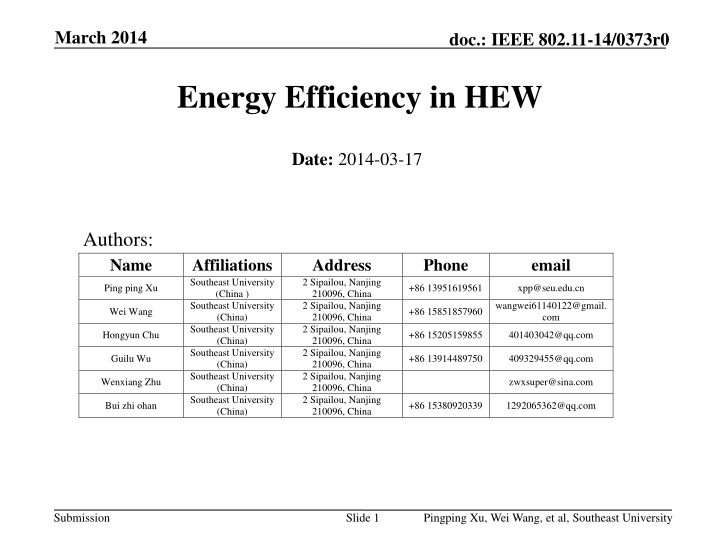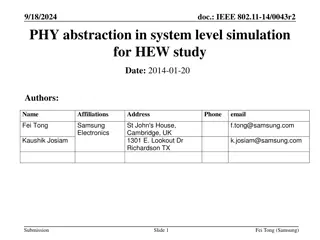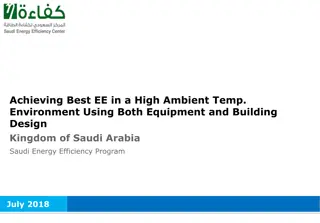Enhancing Energy Efficiency in IEEE 802.11 HEW Standard
The document discusses the focus on improving energy efficiency in the IEEE 802.11 HEW standard to enhance the performance of wireless networks, aiming to complement LTE-based mobile networks. It emphasizes real-world spectrum efficiency enhancements and throughput improvements, particularly in indoor and outdoor deployments with interfering sources in moderate to heavy user-loaded access points. The motivation behind addressing energy efficiency is to reduce inter-cell interference and promote power-saving techniques in MIMO-OFDM-based WLAN systems.
Download Presentation

Please find below an Image/Link to download the presentation.
The content on the website is provided AS IS for your information and personal use only. It may not be sold, licensed, or shared on other websites without obtaining consent from the author.If you encounter any issues during the download, it is possible that the publisher has removed the file from their server.
You are allowed to download the files provided on this website for personal or commercial use, subject to the condition that they are used lawfully. All files are the property of their respective owners.
The content on the website is provided AS IS for your information and personal use only. It may not be sold, licensed, or shared on other websites without obtaining consent from the author.
E N D
Presentation Transcript
March 2014 doc.: IEEE 802.11-14/0373r0 Energy Efficiency in HEW Date: 2014-03-17 Authors: Name Affiliations Southeast University (China ) Southeast University (China) Southeast University (China) Southeast University (China) Southeast University (China) Southeast University (China) Address 2 Sipailou, Nanjing 210096, China 2 Sipailou, Nanjing 210096, China 2 Sipailou, Nanjing 210096, China 2 Sipailou, Nanjing 210096, China 2 Sipailou, Nanjing 210096, China 2 Sipailou, Nanjing 210096, China Phone email Ping ping Xu +86 13951619561 xpp@seu.edu.cn wangwei61140122@gmail. com Wei Wang +86 15851857960 Hongyun Chu +86 15205159855 401403042@qq.com Guilu Wu +86 13914489750 409329455@qq.com Wenxiang Zhu zwxsuper@sina.com Bui zhi ohan +86 15380920339 1292065362@qq.com Submission Slide 1 Pingping Xu, Wei Wang, et al, Southeast University
March 2014 doc.: IEEE 802.11-14/0373r0 Introduction 802.11 HEW will be the standard of the 5G Wi-Fi. It is targeting enhancements to the efficiency and performance of wireless local area networks to make them even better complements to LTE-based mobile networks. Focus on improving real-world, rather than theoretical, spectrum efficiency and area throughput. Aiming to improve the performance of indoor and outdoor deployments in the presence of interfering sources and dense heterogeneous networks in moderate to heavy user-loaded access points[1] Submission Slide 2 Pingping Xu, Wei Wang, et al, Southeast University
March 2014 doc.: IEEE 802.11-14/0373r0 -In most HEW scenarios, the energy source for each user is just a battery, users need to use power efficiently. Suppose a scenario like this, AP work like this Submission Slide 3 Pingping Xu, Wei Wang, et al, Southeast University
March 2014 doc.: IEEE 802.11-14/0373r0 Motivation Energy efficient has been paid increasing attention under the background of limited energy resource and environmental-friendly transmission behaviors, it is also useful aspect to decrease inter-cell interference In MIMO-OFDM-based WLAN, the cross layer (PHY layer and MAC layer )power saving technique improves the power efficiency dramatically[2] Submission Slide 4 Pingping Xu, Wei Wang, et al, Southeast University
March 2014 Dynamic Carrier Sense Ad hoc Traffic Indication Message[3] Mainly improve power save for doze mode Very light traffic case Multiuser resource allocation for power and spectrum efficiency in OFDM system. E.g MAC-PHY layer multi-server-scheduling-based resource allocation algorithms[4] Adaptive transmission power control[5] The solutions above are about previous 802.11 For HEW, we can inherit and improve these method for dense deployed and strong interference scenario doc.: IEEE 802.11-14/0373r0 E.g adaptive transmission power control for MU-MIMO and multiuser resource allocation in beam-forming case Submission Slide 5 Pingping Xu, Wei Wang, et al, Southeast University
March 2014 doc.: IEEE 802.11-14/0373r0 In a dense deployed building, one room deployed one AP. People always three or four stay together, if adaptive transmission power control and multiuser resource allocation in beam-forming can be used in this scenario: Submission Slide 6 Pingping Xu, Wei Wang, et al, Southeast University
March 2014 doc.: IEEE 802.11-14/0373r0 References [1] doc.:IEEE 802.11-14/0214r2 [2] Il-Gu Lee, Jung-Bo Son, Eun-Young Choi, et al. Analysis of Power Consumption and Efficient Power Saving Techniques for MIMO-OFDM-based Wireless LAN Receivers : 2010 Fourth International Conference on Sensor Technologies and Applications pp.597-601, 2010. [3] M.K. Miller and N.H. Vaidya, Improving power save protocols using carrier sensing for dynamic advertisement windows, IEEE MASS, Nov 2005. [4] Y J (Angela) Zhang. A Multi-Server Scheduling Framework for Resource Allocation in Wireless Multi-Carrier Networks IEEE TRANSACTIONS ON WIRELESS COMMUNICATIONS, vol.6 No.11, pp. 3884-3891. [5] B H Jung, H Jin, and D K Sung. Adaptive Transmission Power Control and Rate Selection Scheme for Maximizing Energy Efficiency of IEEE 802.11 Stations 2012 IEEE 23rd International Symposium on Personal, Indoor and Mobile Radio Communications, pp. 266-271,2012. Submission Slide 7 Pingping Xu, Wei Wang, et al, Southeast University























